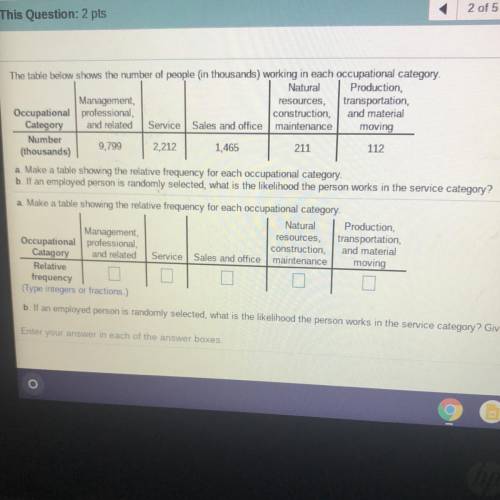
Mathematics, 04.06.2021 18:30 Renebebe1
The table below shows the number of people in thousands) working in each occupational category
Natural
Production
Management
resources, transportation,
Occupational professional
construction and material
Category and related Service Sales and office maintenance moving
Number
9.799 2212
1,465
211
(thousands)
112
a Make a table showing the relative frequency for each occupational category.
bt an employed person is randomly selected what is the likelihood the person works in the service category?
a Make a table showing the relative frequency for each occupational category
Natural Production
Management
resources transportation
Occupational professional
construction and material
Category and related Service Sales and office maintenance
moving
Relative
frequency
beyed person s randomly selected what is the likelihood the person works in the service category? Give the answer as a percentage
Echans er boxes


Answers: 2


Another question on Mathematics

Mathematics, 21.06.2019 16:30
The angles below are supplementary. what is the value of x? a pair of supplementary angles is shown. one angle measures 7x + 33, and the other angle measures 70. 5.3 8.14 11 14.7
Answers: 1

Mathematics, 21.06.2019 18:40
Which compound inequality could be represented by the graph?
Answers: 1

Mathematics, 21.06.2019 20:20
The polynomial 10x3 + 35x2 - 4x - 14 is factored by grouping. 10x3 + 35x2 - 4x - 14 5x )-20 what is the common factor that is missing from both sets of parentheses?
Answers: 2

Mathematics, 22.06.2019 02:30
You are living in aldine, tx and you are planning a trip to six flags in arlington, tx. you look on a map that has a scale of 0.5 inches to 30 miles. if the map shows the scale distance from aldine to arlington is 4 inches, how far is the actual distance?
Answers: 1
You know the right answer?
The table below shows the number of people in thousands) working in each occupational category
Natu...
Questions





Physics, 13.03.2020 19:48

History, 13.03.2020 19:48









Computers and Technology, 13.03.2020 19:48





Mathematics, 13.03.2020 19:48




